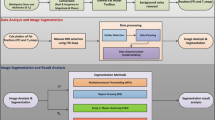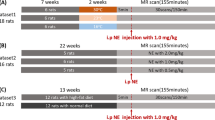Abstract
Objective
The aim was to auto-segment and characterize brown adipose, white adipose and muscle tissues in rats by multi-parametric magnetic resonance imaging with validation by histology and UCP1.
Materials and methods
Male Wistar rats were randomized into two groups for thermoneutral (n = 8) and cold exposure (n = 8) interventions, and quantitative MRI was performed longitudinally at 7 and 11 weeks. Prior to imaging, rats were maintained at either thermoneutral body temperature (36 ± 0.5 °C), or short term cold exposure (26 ± 0.5 °C). Neural network based automatic segmentation was performed on multi-parametric images including fat fraction, T 2 and T 2* maps. Isolated tissues were subjected to histology and UCP1 analysis.
Results
Multi-parametric approach showed precise delineation of the interscapular brown adipose tissue (iBAT), white adipose tissue (WAT) and muscle regions. Neural network based segmentation results were compared with manually drawn regions of interest, and showed 96.6 and 97.1 % accuracy for WAT and BAT respectively. Longitudinal assessment of the iBAT volumes showed a reduction at 11 weeks of age compared to 7 weeks. The cold exposed group showed increased iBAT volume compared to thermoneutral group at both 7 and 11 weeks. Histology and UCP1 expression analysis supported our imaging results.
Conclusion
Multi-parametric MR based neural network auto-segmentation provides accurate separation of BAT, WAT and muscle tissues in the interscapular region. The cold exposure improves the classification and quantification of heterogeneous BAT.






Similar content being viewed by others
References
Bhanu Prakash KN, Gopalan V, Lee SS, Velan SS (2014) Quantification of abdominal fat depots in rats and mice during obesity and weight loss interventions. PLoS One 9(10):e108979
Yaligar J, Gopalan V, Kiat OW, Sugii S, Shui G, Lam BD, Henry CJ, Wenk MR, Tai ES, Velan SS (2014) Evaluation of dietary effects on hepatic lipids in high fat and placebo diet fed rats by in vivo MRS and LC–MS techniques. PLoS One 9(3):e91436
Dixon WT (1984) Simple proton spectroscopic imaging. Radiology 153(1):189–194
Mirbolooki MR, Constantinescu CC, Pan ML, Mukherjee J (2011) Quantitative assessment of brown adipose tissue metabolic activity and volume using 18F-FDG PET/CT and β3-adrenergic receptor activation. EJNMMI Res 1(1):30
Hu HH, Chung SA, Nayak KS, Jackson HA, Gilsanz V (2011) Differential computed tomographic attenuation of metabolically active and inactive adipose tissues: preliminary findings. J Comput Assist Tomogr 35(1):65–71
Baba S, Jacene HA, Engles JM, Honda H, Wahl RL (2010) CT Hounsfield units of brown adipose tissue increase with activation: preclinical and clinical studies. J Nucl Med 51(2):246–250
Bartelt A, Heeren J (2014) Adipose tissue browning and metabolic health. Nat Rev Endocrinol 10(1):24–36
Strobel K, van den Hoff J, Pietzsch J (2008) Localized proton magnetic resonance spectroscopy of lipids in adipose tissue at high spatial resolution in mice in vivo. J Lipid Res 49(2):473–480
Hu HH, Smith DL Jr, Nayak KS, Goran MI, Nagy TR (2010) Identification of brown adipose tissue in mice with fat–water IDEAL-MRI. J Magn Reson Imaging 31(5):1195–1202
Menschik Z (1953) Histochemical comparison of brown and white adipose tissue in guinea pigs. Anat Rec 116(4):439–455
Gilsanz V, Hu HH, Kajimura S (2013) Relevance of brown adipose tissue in infancy and adolescence. Pediatr Res 73(1):3–9
Virtue S, Vidal-Puig A (2013) Assessment of brown adipose tissue function. Front Physiol 4:128
Cannon B, Nedergaard J (2004) Brown adipose tissue: function and physiological significance. Physiol Rev 84(1):277–359
Virtanen KA, Lidell ME, Orava J, Heglind M, Westergren R, Niemi T, Taittonen M, Laine J, Savisto NJ, Enerback S, Nuutila P (2009) Functional brown adipose tissue in healthy adults. N Engl J Med 360(15):1518–1525
Hu HH, Yin L, Aggabao PC, Perkins TG, Chia JM, Gilsanz V (2013) Comparison of brown and white adipose tissues in infants and children with chemical-shift-encoded water–fat MRI. J Magn Reson Imaging 38(4):885–896
Chen YC, Cypess AM, Palmer M, Kolodny G, Kahn CR, Kwong KK (2013) Measurement of human brown adipose tissue volume and activity using anatomic MR imaging and functional MR imaging. J Nucl Med 54(9):1584–1587
Hu HH, Tovar JP, Pavlova Z, Smith ML, Gilsanz V (2012) Unequivocal identification of brown adipose tissue in a human infant. J Magn Reson Imaging 35(4):938–942
Rasmussen JM, Entringer S, Nguyen A, van Erp TG, Burns J, Guijarro A, Oveisi F, Swanson JM, Piomelli D, Wadhwa PD, Buss C, Potkin SG (2013) Brown adipose tissue quantification in human neonates using water–fat separated MRI. PLoS One 8(10):e77907
Bartelt A, Bruns OT, Reimer R, Hohenberg H, Ittrich H, Peldschus K, Kaul MG, Tromsdorf UI, Weller H, Waurisch C, Eychmuller A, Gordts PL, Rinninger F, Bruegelmann K, Freund B, Nielsen P, Merkel M, Heeren J (2011) Brown adipose tissue activity controls triglyceride clearance. Nat Med 17(2):200–205
Clerte M, Baron DM, Brouckaert P, Ernande L, Raher MJ, Flynn AW, Picard MH, Bloch KD, Buys ES, Scherrer-Crosbie M (2013) Brown adipose tissue blood flow and mass in obesity: a contrast ultrasound study in mice. J Am Soc Echocardiogr 26(12):1465–1473
Lindenberg KS, Weydt P, Muller HP, Bornstedt A, Ludolph AC, Landwehrmeyer GB, Rottbauer W, Kassubek J, Rasche V (2014) Two-point magnitude MRI for rapid mapping of brown adipose tissue and its application to the R6/2 mouse model of Huntington disease. PLoS One 9(8):e105556
Sadananthan SA, Zheng W, Chee MW, Zagorodnov V (2010) Skull stripping using graph cuts. NeuroImage 49(1):225–239
Sadananthan SA, Prakash B, Leow MK, Khoo CM, Chou H, Venkataraman K, Khoo EY, Lee YS, Gluckman PD, Tai ES, Velan SS (2015) Automated segmentation of visceral and subcutaneous (deep and superficial) adipose tissues in normal and overweight men. J Magn Reson Imaging 41(4):924–934
Najarian K, Splinter R (2012) Biomedical signal and image processing. CRC Press, London
Sternberg SR (1983) Biomedical image processing. Computer 16(1):22–34
Press WH, Teukolsky SA, Vetterling WT, Flannery BP (1992) Numerical recipes in C: the art of scientific computing. Cambridge University Press, New York
Sirlin CB, Reeder SB (2010) Magnetic resonance imaging quantification of liver iron. Magn Reson Imaging Clin N Am 18(3):359–381
Schneider CA, Rasband WS, Eliceiri KW (2012) NIH Image to ImageJ: 25 years of image analysis. Nat Methods 9(7):671–675
Yushkevich PA, Piven J, Hazlett HC, Smith RG, Ho S, Gee JC, Gerig G (2006) User-guided 3D active contour segmentation of anatomical structures: significantly improved efficiency and reliability. Neuroimage 31(3):1116–1128
Kriegel HP, Kroger P, Zimek A (2010) Outlier detection techniques. In: 10th SIAM international conference on data mining, Columbus, OH
David HA (1979) Robust estimation in the presence of outliers. In: Launer RL, Wilkinson GN (eds) Robustness in statistics. Academic Press, New York, pp 61–74
Kaufman L, Rousseeuw PJ (1990) Finding groups in data: an introduction to cluster analysis. Wiley, New York
Barnett V, Lewis T (1994) Outliers in statistical data. Wiley, Chichester
Ben-Gal I (2005) Outlier detection. In: Maimon O, Rokach L (eds) Data mining and knowledge discovery handbook: a complete guide for practitioners and researchers. Kluwer Academic Publishers, Boston
Lim S, Honek J, Xue Y, Seki T, Cao Z, Andersson P, Yang X, Hosaka K, Cao Y (2012) Cold-induced activation of brown adipose tissue and adipose angiogenesis in mice. Nat Protoc 7(3):606–615
Klaus S (2004) Adipose tissue as a regulator of energy balance. Curr Drug Targets 5(3):241–250
Tam CS, Lecoultre V, Ravussin E (2012) Brown adipose tissue: mechanisms and potential therapeutic targets. Circulation 125(22):2782–2791
Seale P, Lazar MA (2009) Brown fat in humans: turning up the heat on obesity. Diabetes 58(7):1482–1484
Bley TA, Wieben O, Francois CJ, Brittain JH, Reeder SB (2010) Fat and water magnetic resonance imaging. J Magn Reson Imaging 31(1):4–18
Ma J (2008) Dixon techniques for water and fat imaging. J Magn Reson Imaging 28(3):543–558
Leporq B, Lambert SA, Ronot M, Vilgrain V, Van Beers BE (2014) Quantification of the triglyceride fatty acid composition with 3.0 T MRI. NMR Biomed 27(10):1211–1221
Cao Y (2010) Adipose tissue angiogenesis as a therapeutic target for obesity and metabolic diseases. Nat Rev Drug Discov 9(2):107–115
Xue Y, Petrovic N, Cao R, Larsson O, Lim S, Chen S, Feldmann HM, Liang Z, Zhu Z, Nedergaard J, Cannon B, Cao Y (2009) Hypoxia-independent angiogenesis in adipose tissues during cold acclimation. Cell Metab 9(1):99–109
Chen YI, Cypess AM, Sass CA, Brownell AL, Jokivarsi KT, Kahn CR, Kwong KK (2012) Anatomical and functional assessment of brown adipose tissue by magnetic resonance imaging. Obesity (Silver Spring) 20(7):1519–1526
Romu T, Elander L, Leinhard OD, Lidell ME, Betz MJ, Persson A, Enerback S, Borga M (2015) Characterization of brown adipose tissue by water–fat separated magnetic resonance imaging. J Magn Reson Imaging. doi:10.1002/jmri.24931
Lundstrom E, Strand R, Johansson L, Bergsten P, Ahlstrom H, Kullberg J (2015) Magnetic resonance imaging cooling-reheating protocol indicates decreased fat fraction via lipid consumption in suspected brown adipose tissue. PLoS One 10(4):e0126705
Schraml C, Schmid M, Gatidis S, Schmidt H, la Fougere C, Nikolaou K, Schwenzer NF (2015) Multiparametric analysis of bone marrow in cancer patients using simultaneous PET/MR imaging: correlation of fat fraction, diffusivity, metabolic activity, and anthropometric data. J Magn Reson Imaging 42(4):1048–1056
Raylman RR, Majewski S, Velan SS, Lemieux S, Kross B, Popov V, Smith MF, Weisenberger AG (2007) Simultaneous acquisition of magnetic resonance spectroscopy (MRS) data and positron emission tomography (PET) images with a prototype MR-compatible, small animal PET imager. J Magn Reson 186(2):305–310
Acknowledgments
This research was supported by the intramural funding of Singapore Bioimaging Consortium, A*STAR, Singapore.
Author contributions

Author information
Authors and Affiliations
Corresponding author
Ethics declarations
Conflict of interest
The authors declare no conflict of interest.
Ethical approval
All procedures performed in studies involving animals were in accordance with the ethical standards of the institutional animal care and use committee of biological resource center, A*STAR.
Human and animal rights and informed consent
All animal procedures were conducted in accordance with protocols approved by the institutional animal care and use committee of biological resource centre, Agency for Science Technology and Research (A*STAR), Singapore.
Additional information
K. N. Bhanu Prakash, Sanjay K. Verma and Jadegoud Yaligar have contributed equally to this work.
Rights and permissions
About this article
Cite this article
Bhanu Prakash, K.N., Verma, S.K., Yaligar, J. et al. Segmentation and characterization of interscapular brown adipose tissue in rats by multi-parametric magnetic resonance imaging. Magn Reson Mater Phy 29, 277–286 (2016). https://doi.org/10.1007/s10334-015-0514-3
Received:
Revised:
Accepted:
Published:
Issue Date:
DOI: https://doi.org/10.1007/s10334-015-0514-3




